Vincentown, New Jersey
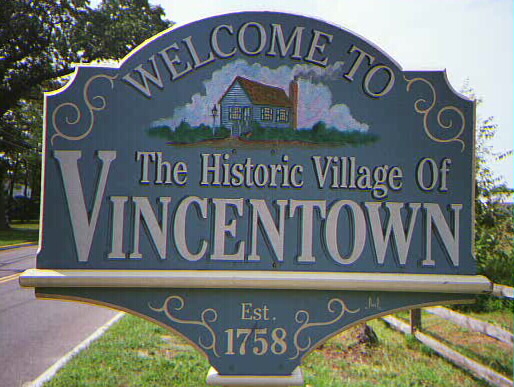


"Even so, there are other places where the locals go to trade talk and to eat -- two diners, a cafe*, and the Red Lion Inn, where the owners still make their own pasta."
*Editor's note: Since this article appeared, the cafe on Main Street has closed.
People in Southampton like their space. "I can drop out of society when I pull into my driveway," said one resident. "All my neighbors are four-legged, and that's the way I like it." he said. "No, I hope a lot of people don't decide to move here. It's very rural, very private."
In 1977, a reporter for the Burlington County Times, Dan Eisenhuth, wrote an article about Vincentown which has been a classic description of the town. At the time, Dan lived on Mill Street. The article has been reproduced in local newsletters and has been read publicly at Historical Society meetings and is quoted frequently by people desirous of preserving the unique attributes which make Vincentown special. We have reproduced the article, as well as a commentary and update, some twenty years later, by another transplant to Vincentown, Joe Laufer. Click below to read both these articles.
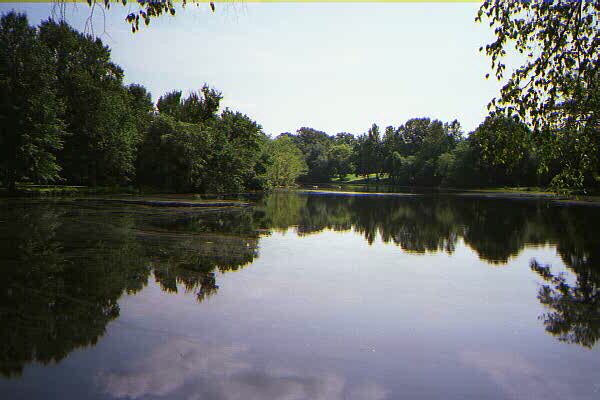

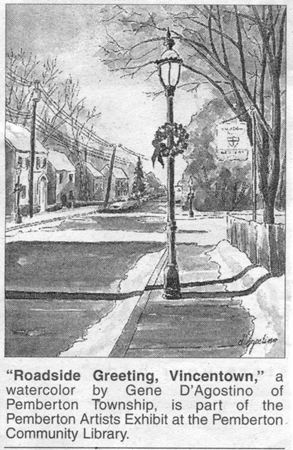
David Brainard, the celebrated missionary to the Indians, came upon the Coaxen while the tribe lived along the branch of the Rancocas Creek that flows through Vincentown and the Stop the Jade Creek that empties into the Rancocas. His brother, John Brainard, equally celebrated Presbyterian missionary, built the first church about the year 1774. A second church, a Quaker Meeting House, was built where the present Grange Hall now stands. A deed dated July 1781 shows that the ground was purchased from Anna Stockton Leeds, widow of Vincent, for five shillings.
The Post Office in Vincentwon obtained its United States Postal Service charter on April 22, 1824; Mahlon Sleeper was the first Postmaster.
The first sawmill was built by Joseph Burr, John Burr's son, in 1775; a grist mill was built in 1812.
Gordon's Gazette of 1834 lists Vincentown as a "post town of Northampton Township. It contains a grist mill, a saw mill, 2 taverns, 4 stores, from 30 to 40 dwellings, a Quaker Meeting House and a House of Public Worship, free to all denominations."
Barker and Howe's Historical Collections of 1844 credits the town as "a flourishing village, mostly grown up since the Revolutionary War. The Village is compactly built, principally on a single street. It contains 4 stores, a grist mill, a turning mill, and extensive tannery, a select school (Quaker), 1 Baptist, 1 Methodist, and a Friend's Meeting House; 90 dewellings, and about 600 inhabitants.
A stage coach ran from Mount Holly to Vincentown, in the township that was incorporated in 1845 and named Southampton.
Many well-known men and women of the area received their education at the "select schools". The Herbert School, established in 1858 by John G. Herbert, was located on Plum Street; and continued to educate for 40 years. Mr. Herbert established the first free library in Vincentown on Main Street, using books from his personal library. The Village School originally located on Race Street, was moved from its original location on North Main Street next to Allen's Oil Company in 1981. Fondly named the William K. Haines School in honor of its first schoolmaster, it was restored by and is in the care of the Southampton Historical Society, which oversaw its relocation to its present pituresque setting in the Village Mill Dam Park on the Rancocas Creek.
The Vincent Fire Company was organized October 7, 1850. The first piece of equipment, which the company still owns, was a hand pump received on February 17, 1851. On ground purchased from Mr. John B. Irick for $100, a fire house was built on Main Street in 1915. Today, this building, adjacent to the Sally Stretch Keen Memorial Library, is the Children's Library. The present fire house on Race Stereet was built in 1974.
A charter was granted to the First National Bank of Vincentown in 1864; William Irick was its first president. The bank, located at the corner of Mill St. and Main St., operated continuously for 134 years under six different names, closed briefly (February 20, 1998 through October, 1999) and currently (2001) operates as Sterling Bank. The dates of the various coporate operations are: The First National Bank of Vincentown (1864-1963), Union National Bank (Sept., 1963-May, 1970), South Jersey National Bank (May, 1970-May, 1971), Heritage Bank (May, 1971-Sept., 1986), Midlantic Bank (Sept., 1986-Sept., 1996), PNC Bank (Sept., 1996-February 20, 1998). When the bank closed in 1998, no corporate financial instutution stepped forward to take it over. Community leaders courted various institutions to re-open the bank, and finally, in late 1999, the bank reopened as Sterling Bank, the current operator.
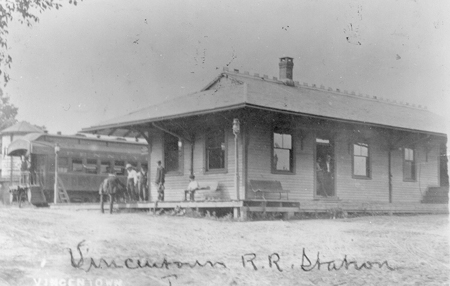
A vital part of the community in the late 1800's was the Vincentown branch of the Camden and Burlington Railroad Company. It was incorporated on March 15, 1861, and by 1864 the road ran from Ewansville to Vincentown, parallel to Route 206. The railroad was used both as transportation for folks working in various parts of Camden and Burlington County and for transportation of cattle, milk, and produce to market. A spur was built especially to haul the marl from the local marl pits to other parts of the state. The Railroad ran until 1928.
In 1923, the Sally Stretch Keen Memorial Library was built and endowed by Mrs. George W. Childs Drexel of Bryn Mawr, Pennsylvania, in memory of her mother.
The Vincentown Grange, organized in the 1800's, reorganized in 1907, is still very active in the community. It occupies the building which was once the Quaker Meeting House in the community, dating back to 1813.
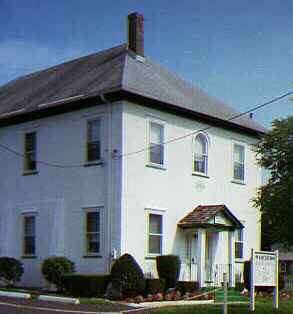
In 1915 a group of women began the Village Improvement Association. In 1939 the club was federated and in 1963 became the Village Women's Club. The group recently disbanded.
The indepenent telephone company of Vincentown was incorporated in 1908 and served the community in its building on Mill Street until 1930 when it was sold to New Jersey Bell as the dial system came into use. Now, the Vincentown-Tabernacle Telephone building on Mill Street is the headquarters of the Southampton Historical Society, founded in 1974. Among its important works in the community, the Society has undertaken the restoration of the Vincentown-Tabernacle Telephone Building, the preservation of the telephone equipment and records, and operates a telephone museum in the building.
Vincentown was placed on the New Jersey Register of Historic Places on April 14, 1987. Vincentown was placed on the National Register of Historic Places on September 21, 1988.
